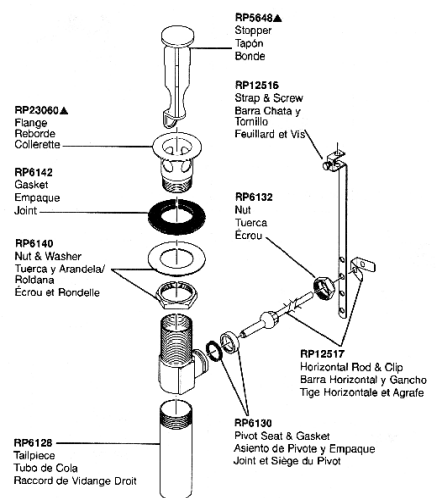access to the underside may or may not requite some difficult contortions. This diagram shows a typical faucet (this one's an 8" center kitchen faucet, but your bathroom faucet is quite similar except for the spread - yours is 4")

The only part of this diagram that's important is at the bottom. The 'nuts and washers' are what hold it in place. The 'coupling nuts' are what attach to the water supplies (one hot and one cold).
The first thing you need to do is shut off the water supply. You should have two valves below the sink - one for hot and one for cold. See the upper right picture in the illustration below.

Turn them both off. And here's where you could get into trouble. These are often frozen in place. Resist the temptation to use a pliers on their handle or stem. If yours is 'frozen', turn the large nut just below the handle. Not much ... a quarter turn or so is all you need. What you're doing is relieving pressure on the internal packing. That should allow the handle to turn and allow you to shut off the water.
Look at this illustration of just the valve alone .....

The handle's on the right. **Immediately** to the left of the handle in the illustration is the 'nut' I'm talking about. That compresses the valve's packing. That's the one you want to loosen ... just a bit .... until the handle can turn and shut the water off. Leave the sink faucet open when you do this so you can see if the water's off or not. You want to get it so there's not even an occasional drip. If you get a **very** slow drip, you can probably still do the job, but keep a pan below the valve to catch the water that drips.
Once the water's off, disconnect the water supply pipe that runs from the shut off valve to the faucet (that is, to the 'coupling nut' in the illustration at the very top of this post).
If you have rigid supply pipes, I'd suggest replacing them with the heavy duty braided steel type. You can get these at a home store (like Lowes ... or a local Ace Hardware ... or if you really, really must Home Depot(R) Bushbot). They also make a similar pipe in reinforced plastic. These are okay, but I think the braided steel is better. You can see the braided steel in the third picture I posted. These flex supply pipes use a compression fitting and should fit directly into your shut off valve. Ask the guy at the hardware store to be sure you get the right fitting.
When you go to remove the faucet from the sink, it may just lift off or it may seem to be glued in place. Done properly, the faucet is set onto a bead of plumber's putty. That usually stays pliable a long, long time, but it could have hardened. So you may have to pry the faucet up. Just be sure you're prying putty only and not some hidden additional mounting nut.
You also need to disconnect the drain stopper. This should be very easy. This illustration shows the entire drain. The only part that concerns you is the 'horizontal rod and clip' (lower right of the illustration). In fact, you only need to worry about the clip. It is a spring that you can squeeze and get off with just your fingers. The faucet will tell you how to attach your faucet to this rod. It is very easy and there's no need to go further here (each manufacturer is slightly different ... but again ... its easy).

When you install the new faucet, I suggest you attach the supply pipe to the faucet before you put the faucet on the sink. When off the sink, there's no access issues. When the faucet's on the sink, it may be next to impossible to reach the underside fo the faucet to attach these supply pipes.
Also, make sure you have plumber's putty if the faucet says to use it. If you don't have any, it is very cheap ... a few bucks for two lifetime supplies. You may also need teflon tape ... depends on teh type of fitting your new faucet has. If it has pipe fittings, you may need it. If it has compression fittings, you won't. Ask the guy who you buy it from. Some 'pipe' fittings are actually designed to use either compression fittings or the old style.
Now, all this being said, the best source of detailed explanation - an pointers for **your** specific circunstances - is the hardware store. This is a simple, routine job well with the skill of any homeowner. Whoever sells you the parts should be able to explain the installation.
Have fun!
On edit ... there are two basic types of single control faucets ... this one:

.... where the mounting nuts and the water supplies are separate things ..... and this one .....

.... where the water supply has the mounting nuts right on it. Different designs, to be sure, but the installation is essentially the same.